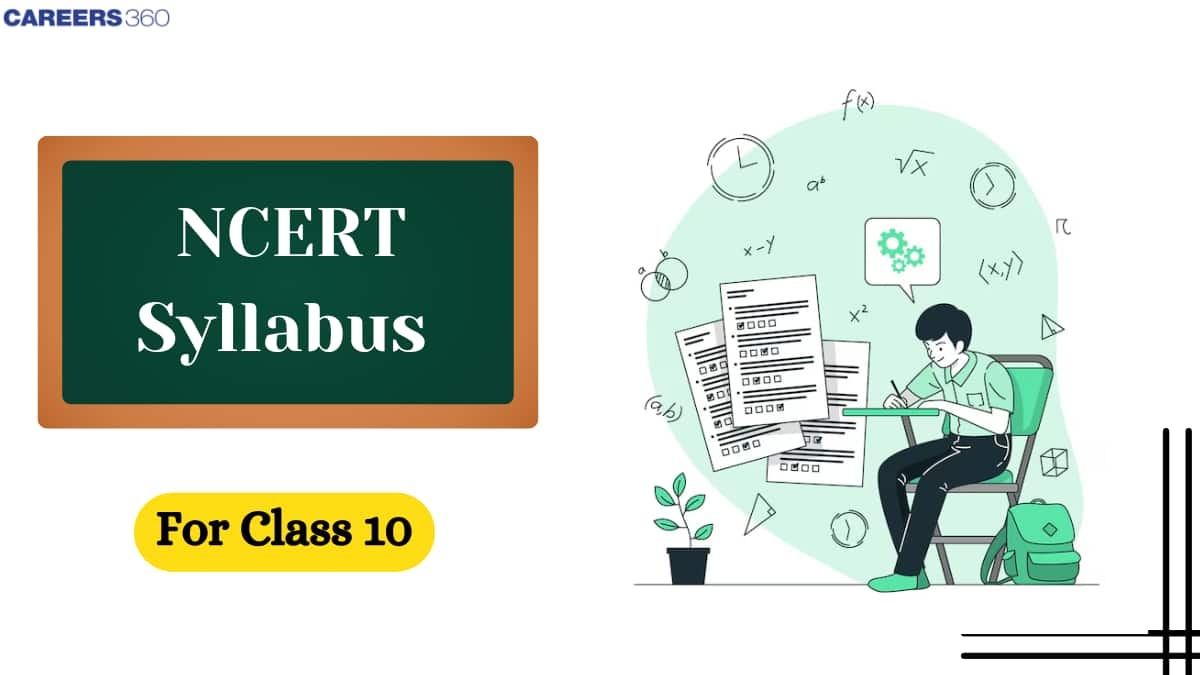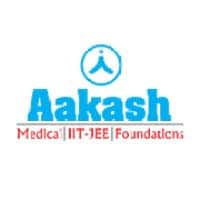Aakash Repeater Courses
ApplyTake Aakash iACST and get instant scholarship on coaching programs.
The NCERT Syllabus for Class 10 provides students with the knowledge of what they have to study throughout the year. The syllabus is well-structured and follows a step-by-step approach to learning. It can be downloaded from the official NCERT website which is ncert.nic.in. Knowing the NCERT syllabus helps students plan their studies better and stay focused. It also gives students a clear idea of important topics and chapters for the exams.

In various competitive exams, the Class 10 NCERT Syllabus plays an important role. Many questions are directly asked from this syllabus in the exams. Understanding the exam pattern and marking scheme helps students study smartly. It also allows students to focus on the right topics instead of wasting time on less important areas. Staying updated with the latest syllabus keeps their preparation on the right track. NCERT Books and Solutions based on this syllabus make difficult topics easy to learn.
Students who are preparing for the board exams should know what topics they need to study. It’s also helpful to understand how marks are given for reading, writing, grammar, and literature. The Class 10 NCERT Syllabus for English is given below. It helps students prepare in the right way.
Prose
| Chapter No. | Title |
|---|---|
| 1 | A Letter to God |
| 2 | Nelson Mandela: Long Walk to Freedom |
| 3 | Two Stories About Flying |
| 4 | From the Diary of Anne Frank |
| 5 | Glimpses of India |
| 6 | Mijbil the Otter |
| 7 | Madam Rides the Bus |
| 8 | The Sermon at Benares |
| 9 | The Proposal |
Poetry
| Poem No. | Title |
|---|---|
| 1 | Dust of Snow |
| 2 | Fire and Ice |
| 3 | A Tiger in the Zoo |
| 4 | How to Tell Wild Animals |
| 5 | The Ball Poem |
| 6 | Amanda! |
| 7 | The Trees |
| 8 | Fog |
| 9 | The Tale of Custard the Dragon |
| 10 | For Anne Gregory |
Footprints Without Feet (Supplementary Reader)
| Chapter No. | Title | Theme |
|---|---|---|
| 1 | A Triumph of Surgery | Pet care and clever deception |
| 2 | The Thief’s Story | Trust and change |
| 3 | The Midnight Visitor | Smart spy work |
| 4 | A Question of Trust | Irony in theft |
| 5 | Footprints Without Feet | Science fiction (invisibility) |
| 6 | The Making of a Scientist | Hard work and curiosity |
| 7 | The Necklace | Vanity and truth |
| 8 | Bholi | Education and self-respect |
| 9 | The Book That Saved the Earth | Science fiction and humor |
Words and Expressions-2
Before starting their studies, students should be familiar with the chapters and important topics included. The NCERT Class 10 Syllabus for Social Science 2025-26 includes History, Geography, Political Science, and Economics. Students can check below to see all the chapters and topics included for this year.
| Subject | Chapter No. | Chapter Title | Key Topics |
|---|---|---|---|
| History (India and the Contemporary World-II) | 1 | The Rise of Nationalism in Europe | French Revolution, Unification of Germany and Italy, Nationalism and imperialism |
| 2 | Nationalism in India | Gandhiji, Non-Cooperation, Civil Disobedience, Role of social groups | |
| 3 | The Making of a Global World | Pre-modern world, Industrialisation, World trade, Globalisation | |
| 4 | The Age of Industrialisation | Pre-Industrial era, Factory system, Industrialisation in colonies | |
| 5 | Print Culture and the Modern World | Development of print, Print in Europe and India, Social impact | |
| Geography (Contemporary India) | 1 | Resources and Development | Types of resources, Resource planning, Land use, Soil types |
| 2 | Forest and Wildlife Resources | Biodiversity, Conservation, Flora and fauna, Environmental issues | |
| 3 | Water Resources | Water scarcity, River projects, Rainwater harvesting | |
| 4 | Agriculture | Farming types, Cropping patterns, Major crops, Reforms | |
| 5 | Minerals and Energy Resources | Types of minerals, Energy sources, Conservation | |
| 6 | Manufacturing Industries | Importance, Industry types, Distribution, Pollution control | |
| 7 | Lifelines of National Economy | Transport, Communication, Trade, Tourism, Infrastructure | |
| Political Science (Democratic Politics) | 1 | Power Sharing | Belgium and Sri Lanka, Importance, Types of power sharing |
| 2 | Federalism | Meaning, Federalism in India, Decentralisation | |
| 3 | Gender, Religion and Caste | Gender politics, Communalism, Caste system | |
| 4 | Political Parties | Party types, National vs Regional parties, Challenges | |
| 5 | Outcomes of Democracy | Government accountability, Development, Inequality, Poverty | |
| Economics (Understanding Economic Development) | 1 | Development | Development goals, National development, Indicators |
| 2 | Sectors of the Indian Economy | Primary, Secondary, Tertiary sectors, GDP, Employment | |
| 3 | Money and Credit | Role of money, Formal and informal credit, Self Help Groups | |
| 4 | Globalisation and the Indian Economy | What is globalisation, Liberalisation, MNCs, Impact on India | |
| 5 | Consumer Rights | Consumer movement, Rights and duties, Legal protections |
Students preparing for board exams are usually worried about Maths. But if they give enough time to each chapter and practice regularly, they can score good marks. Check the NCERT Class 10 Syllabus for Maths and prepare and score well in their exam.
| Chapter No. | Chapter Title | Key Topics |
|---|---|---|
| 1 | Real Numbers | Fundamental Theorem of Arithmetic, Revisiting Irrational Numbers |
| 2 | Polynomials | Zeros of a polynomial (geometric meaning), Relationship between zeros and coefficients |
| 3 | Pair of Linear Equations in Two Variables | Graphical method, Algebraic methods – Elimination and Substitution methods |
| 4 | Quadratic Equations | Factorisation method, Nature of roots |
| 5 | Arithmetic Progressions | nth term of an AP, Sum of first n terms |
| 6 | Triangles | Similar figures, Similarity criteria, Properties of similar triangles |
| 7 | Coordinate Geometry | Distance formula, Section formula |
| 8 | Introduction to Trigonometry | Trigonometric ratios, Specific angles, Identities |
| 9 | Some Applications of Trigonometry | Heights and distances |
| 10 | Circles | Tangent to a circle, Number of tangents from a point |
| 11 | Areas Related to Circles | Area of sector and segment of a circle |
| 12 | Surface Areas and Volumes | Surface area and volume of combination of solids |
| 13 | Statistics | Mean, Mode, and Median of grouped data |
| 14 | Probability | Theoretical approach to probability |
Science is an interesting and fun subject. With a good understanding and regular study, students can perform well in it. The NCERT Syllabus for Class 10 Science is divided into 13 chapters. Below are the chapters and topics students will study in the science subject.
| Chapter No. | Chapter Name | Topics Covered |
|---|---|---|
| Chapter 1 | Chemical Reactions and Equations | • Chemical reactions • Types of chemical reactions • Writing chemical equations • Balancing chemical reactions • Effects of chemical reactions in daily life |
| Chapter 2 | Acids, Bases, and Salts | • Properties of acids and bases • Indicators • Common acids and bases • Neutralisation • Salts and their uses |
| Chapter 3 | Metals and Non-metals | • Physical properties of metals and non-metals • Chemical properties of metals and non-metals • Reactivity series • Corrosion and its prevention |
| Chapter 4 | Carbon and Its Compounds | • Allotropes of carbon • Physical and chemical properties of carbon compounds • Types of carbon compounds (hydrocarbons, alcohols, acids) • Uses of carbon compounds |
| Chapter 5 | Life Processes | • Nutrition in plants and animals • Respiration • Transportation in animals and plants • Excretion |
| Chapter 6 | Control and Coordination | • Human Nervous system • Reflex actions • Sense organs • Hormones and their functions |
| Chapter 7 | How do Organisms Reproduce? | • Modes of reproduction • Asexual reproduction • Sexual reproduction • Reproductive health |
| Chapter 8 | Heredity | • Traits and inheritance • Variation in traits • Basics of genetics • Importance of heredity |
| Chapter 9 | Light, Reflection and Refraction | • Nature of light • Reflection of light • Refraction of light • Image formation by mirrors and lenses |
| Chapter 10 | The Human Eye and the Colourful World | • Structure of the human eye • Common eye defects and their correction • Dispersion of light • Rainbows and colours |
| Chapter 11 | Electricity | • Electric current and circuits • Conductors and insulators • Effects of electric current • Safety measures |
| Chapter 12 | Magnetic Effect of Electric Current | • Magnetic fields • Electromagnets • Working of an electric bell • Uses of electromagnets |
| Chapter 13 | Our Environment | • Ecosystems • Pollution and its types • Conservation of natural resources • Waste management |
The syllabus of Hindi has two sections, Course A and Course B. Both sections contain two books. The detailed syllabus is given below:
| खंड | पाठ / कविता का नाम | लेखक / कवि |
|---|---|---|
| काव्य खंड | पद | सूरदास |
| राम-लक्ष्मण-परशुराम संवाद | तुलसीदास | |
| साखियाँ और सबद | कबीर | |
| यह दंतुरित मुस्कान और फसल | नागार्जुन | |
| टोपी शुक्ला | कुँवर नारायण | |
| बालगोबिन भगत | हरिशंकर परसाई | |
| आत्मत्राण | माखनलाल चतुर्वेदी | |
| उत्साह और अट नहीं रही | रामधारी सिंह दिनकर | |
| गद्य खंड | गिरगिट | अन्तोन चेखव |
| स्पर्श | रवींद्रनाथ ठाकुर | |
| नेताजी का चश्मा | सुभाष चंद्र बोस | |
| बालगोबिन भगत | हरिशंकर परसाई | |
| डायरी का एक पन्ना | सुभद्राकुमारी चौहान | |
| तितली | जगबीर राठी | |
| मैं क्यों लिखता हूँ | अज्ञेय |
The syllabus is given below:
| पाठ का नाम | लेखक |
|---|---|
| माता का आँचल | शील |
| जुलूस | फणीश्वरनाथ रेणु |
| साना साना हाथ जोड़ि | मन्नू भंडारी |
| एही ठैयाँ झुलनी हेरानी हो रामा! | कन्हैयालाल मिश्र 'प्रभाकर' |
| मैं क्यों लिखता हूँ | सच्चिदानंद हीरानंद वात्स्यायन 'अज्ञेय' |
| पाठ / कविता का नाम | कवि / लेखक | मुख्य विषय |
|---|---|---|
| साखी | कबीर | संत शिक्षा, समाज पर प्रभाव |
| पद | मीरा | भक्ति, श्रीकृष्ण प्रेम |
| मनुष्यता | मैथिलीशरण गुप्त | नैतिकता, संस्कृति, कर्तव्य |
| पर्वत प्रदेश के पावस | सुमित्रानंदन पंत | प्रकृति सौंदर्य, ऋतु परिवर्तन |
| तोप | वीरेन डंगवाल | युद्ध, शांति, मानवता |
| कर चले हम फ़िदा | कैफ़ी आज़मी | देशभक्ति, बलिदान |
| आत्मत्राण | रवींद्रनाथ ठाकुर | आत्मज्ञान, आत्मनिर्भरता |
| बड़े भाई साहब | प्रेमचंद | अनुशासन, शिक्षा, पारिवारिक संबंध |
| डायरी का एक पन्ना | सीताराम सेकसरिया | आत्मचिंतन, संवेदनशीलता |
| तताँरा वामीरो कथा | लीलाधर मंडलोई | स्त्री स्थिति, परंपरा व बदलाव |
| तीसरी कसम के शिल्पकार शैलेंद्र | प्रह्लाद अग्रवाल | साहित्य व सिनेमा, शैलेंद्र का योगदान |
| अब कहाँ दूसरे के दुख से दुखी होने वाले | निदा फ़ाज़ली | सामाजिक उदासीनता, संघर्ष |
| पतझर में टूटी पत्तियाँ (गिन्नी का सोना, झेन की देन) | रवींद्र केलेकर | जीवन मूल्यों की पहचान, आत्मबोध |
| कारतूस (एकांकी) | हबीब तनवीर | समाज में बदलाव, परंपरा और आधुनिकता |
| पाठ का नाम | लेखक | मुख्य विषय |
|---|---|---|
| हरिहर काका | मिथिलेश्वर | ग्रामीण जीवन, परिवारिक संघर्ष, सामाजिक अधिकार |
| सपनों के से दिन | गुरदयाल सिंह | युवाओं की चुनौतियाँ, आत्मनिर्भरता, प्रेरणादायक कहानी |
| टोपी शुक्ला | राही मासूम रज़ा | सामाजिक विडंबनाएं, इंसान की मानसिकता और उसके कर्म |
Download: NCERT Syllabus for Class 10 PDF download Hindi
Students who want to get the latest syllabus can download it easily from the official website. Follow the simple steps which are mentioned below to access the syllabus.
Step 1: Go to the official NCERT website at http://ncert.nic.in.
Step 2: On the home page, in the 'Search' option and type 'Syllabus' and click on it. This will take you to the syllabus page.
Step 3: Click on the 'Syllabus For Secondary and Higher Secondary Classes' option. The syllabus PDF will open.
Step 4: Choose the "Class X Syllabus" of the required subject in the PDF.
Step 5: The Class 10 NCERT Syllabus of the selected subject will be displayed on your screen. Download and save it for future use.
Note*: The Class 10 Syllabus is not updated on the NCERT official website. Students can download the latest syllabus from the Careers360 page.
Also Read,
Students should always use the books recommended by experts for Class 10 preparation. These books follow the latest syllabus and exam pattern. They are written in simple language and also explain each topic clearly. These NCERT Class 10 books are available in both printed and PDF formats from the official website. One big benefit of using these books is that many questions in competitive exams come directly from them. They are written by well-known authors and have practice exercises after each chapter. Therefore, students must study from these books during exam preparation.
Subject-wise NCERT 10th books 2025-26:
A total of 5 subjects, namely science, mathematics, English, social science, and hindi, are included in the NCERT Syllabus for Class 10.
No, NCERT is not the CBSE syllabus, but CBSE follows the NCERT syllabus.
NCERT creates textbooks and curriculum guidelines, while CBSE is a board that conducts exams.
Yes, the NCERT Syllabus for Class 10 is the same for the CBSE syllabus for Class 10.
The 10th board is not very hard if students study regularly. If they understand the basics and practice well, it becomes easy to understand the NCERT Syllabus for Class 10. Time management and revision are very important to score well.
Yes, NCERT books are enough for Class 10 board exams.
Application Date:24 July,2025 - 23 August,2025
Application Date:24 July,2025 - 23 August,2025

Take Aakash iACST and get instant scholarship on coaching programs.

This ebook serves as a valuable study guide for NEET 2025 exam.

This e-book offers NEET PYQ and serves as an indispensable NEET study material.

As per latest syllabus. Physics formulas, equations, & laws of class 11 & 12th chapters

As per latest syllabus. Chemistry formulas, equations, & laws of class 11 & 12th chapters
As per latest 2024 syllabus. Study 40% syllabus and score upto 100% marks in JEE